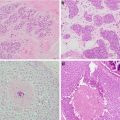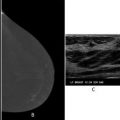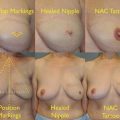Gene
Mammographya
RRM
RRSO
Colonoscopy
RR proctocolectomy
Pancreatic screening
RR gastrectomy
Tung
NCCN
Tung
NCCN
Tung
NCCN
Tung
NCCN
Tung
NCCN
Tung
NCCN
Tung
NCCN
ATM
Annually starting at age 40
Annually starting at age 40
NA
IE
FH
NC
NC
NA
NC
NC
Clinical trial
NC
NC
NC
CHEK2 (truncating)
Annually starting at age 40
Annually starting at age 40
NA
IE
FH
NC
Discuss at age 40
Every 5 years, starting at age 40
NC
NC
NC
NC
NC
NC
NBN
Annually starting at age 40
Annually starting at age 40
NA
NA
FH
NC
NC
NC
NC
NC
NC
NC
NC
NC
PALB2
Annually starting at age 30
Annually starting at age 40
NA
DO
FH
IE
NC
NC
NC
NC
Clinical trial
NC
NC
NC
BRIP1
RAD51C
RAD51D
FH
FH
NA
NC
R/C at age 50–55
R/C at age 45–50
NC
NC
NC
NC
NC
NC
NC
NC
APC
NC
NC
NC
NC
NC
NC
FH b
Annually starting at age 10–15
NC
R/C at age 20
NC
Clinical trial
NC
NC
CDH1
NC
Annually starting at age 30
NA
DO
NA
NA
NC
NC
NC
NC
NC
NC
NC
FH
Patients with high-penetrance mutations in TP53, PTEN, STK11, and CDH1 can be managed according to established guidelines for each associated hereditary cancer syndrome. For instance, it has been shown that patients with a TP53 mutation are at higher risk of secondary radiation-induced malignancies [43]. In these patients, avoidance of radiotherapy is recommended, and a bilateral mastectomy is favored. It is important to note that TP53 mutation carriers tend to have an earlier age of breast cancer diagnosis with an average age of 30 at the time of diagnosis. Thus, multigene panel testing should be considered in young breast cancer patients who test negative for BRCA1/BRCA2 mutations. Early identification of CDH1 mutation carriers is also critical, as these patients have a higher lifetime risk of developing diffuse gastric cancer and lobular breast cancer. Given the high mortality associated with diffuse gastric cancer, prophylactic total gastrectomy is recommended in these patients [44].
When a mutation carrier is identified, one of the most important things to do is cascade testing of as many at-risk relatives as possible. The identification of family members will markedly improve outcomes by identifying patients who are at extremely high risk and managing them in a way that will detect cancer earlier or prevent cancer altogether.
Cascade genetic screening is a methodology for identifying and testing family members at increased risk for a heritable disease. Cascade screening follows a systematic process of family tracing which minimizes costs and the number of family members who need to be tested. In 2012, the Center for Disease Control (CDC) developed an evidence-based classification schema for genomic applications in public health and clinical settings. Cascade screening was included as a Tier 1 application. Tier 1 genomic applications are defined as those having “significant potential for positive impact on public health” and include applications for HBOC and Lynch syndrome , as well as familial hypercholesterolemia [45]. The CDC recommends a two-phase approach for HBOC with the Phase 1 approach including (1) enhancing cancer registry reporting, (2) informing evidence-based policy-making by partner payers to enhance coverage, (3) developing and tracking surveillance indicators, and (4) instituting outreach programs. The Phase 2 approach uses cascade screening to identify at-risk family members who may benefit from preventive strategies [46].
Previously Diagnosed Patients Who Develop Local Recurrence
BRCA1-/BRCA2-positive patients with stage I/II breast cancer have a 12.9% 10-year risk of developing an ipsilateral breast recurrence [47]. These patients may elect to undergo completion mastectomy with or without contralateral prophylactic mastectomy. After undergoing treatment, these patients require close follow-up in the same manner as all breast cancer patients.
Previously Diagnosed Patients Who Develop Distant Metastasis
Mutation status can potentially help guide systemic therapy decisions in BRCA mutation carriers who develop distant metastases. While still under study, it appears that cisplatin chemotherapy and PARP inhibitors (small molecular inhibitors of the enzyme poly ADP-ribose polymerase) may be more effective in BRCA mutation carriers [48]. Developing data shows that BRCA1-associated cancers are more sensitive to platinum therapy and less sensitive to taxanes [49, 50]. BRCA1-positive patients with breast cancer who are treated with cisplatin in both the neoadjuvant and metastatic setting have been shown to respond well to treatment [51]. Preclinical studies in breast cancer models show that the combination of a PARP1 inhibitor with cisplatin induces a larger response in BRCA2-deficient tumors than either compound alone [52]. Currently, clinical trials with several PARP inhibitors are being conducted to assess the toxicities, efficacies, and benefits of the drugs in BRCA1-/BRCA2-related breast cancer [53, 54]. PTEN-deficient tumors have also been shown to be sensitive to PARP inhibitors both in vitro and in vivo suggesting that treatment with PARP inhibitors may be considered for those with PTEN-positive breast cancer in the near future [55]. A similar result has been shown in ATM-deficient cells indicating that ATM depletion sensitizes breast cancer cells to PARP inhibitors [56].
Newly Diagnosed Breast Cancer Patients
Most newly diagnosed patients accept genetic counseling and testing when offered [57]. Newly diagnosed breast cancer patients identified as mutation carriers have the option of breast-conserving therapy versus mastectomy with or without contralateral prophylactic mastectomy. In a prospective study of 194 newly diagnosed breast cancer patients, 48% of patients found to carry a BRCA1/BRCA2 mutation chose bilateral mastectomy as their definitive breast cancer surgery compared to 24% of patients in whom no mutation was detected, highlighting the significance of genetic testing in newly diagnosed patients in surgical decision-making [58]. It has been shown that women found to have a mutation would have opted for bilateral mastectomy if they had been identified as mutation carriers at the time of diagnosis [59]. Knowledge of one’s mutation status prior to definitive surgery may help women avoid a second surgery for those who would have chosen bilateral mastectomy over breast-conserving therapy. Patients with knowledge of their mutation status at the time of diagnosis may also avoid radiation therapy after breast-conserving surgery, which may negatively affect the cosmetic outcome of reconstructive surgery. As mentioned above, platinum-based chemotherapy may be preferentially considered as systemic therapy for BRCA1 mutation carriers, and PARP inhibitors have thus far shown great potential in clinical trials.
Breast Cancer Risk Prediction Models
Numerous risk models have been developed that use mathematical strategies to predict the risk of having a mutation in a cancer susceptibility gene such as BRCA1/BRCA2. These models, used in conjunction with clinical guidelines and judgment, can assist in determining the need for a genetic counseling referral and genetic testing. While many models focus on predicting BRCA mutation carrier status, the top three in terms of validation and common use in clinical practice are Myriad, BRCAPRO, and BOADICEA.
The Myriad model (Myriad I, also known as the Shattuck-Eidens model) predicts the risk of having a deleterious BRCA1 mutation based on logistic regression analysis of a group of 798 women who underwent genetic sequencing by Myriad laboratories [60]. The risk factors incorporated into this prediction model are age of first diagnosis of breast or ovarian cancer, Ashkenazi Jewish ethnicity, diagnosis of bilateral breast cancers, number of relatives (any degree) affected by breast cancer, number of relatives (any degree) affected by ovarian cancer, and number of relatives (any degree) affected by both breast and ovarian cancer. The Myriad II model, sometimes referred to as the Frank model [61], also uses logistic regression to refine its correlations between similar risk factors and mutation status albeit in a larger cohort of 10,000 women. Risk factors incorporated into the Myriad II tables include personal breast cancer history, with age of onset of breast cancer categorized as ≥50 or <50, history of ovarian cancer, history of male breast cancer, and the combination of both breast and ovarian cancer. The family history assessment includes breast cancer accounting for age (≥50 or <50) and ovarian cancer at any age in first- or second-degree relatives. In contrast to Myriad I, this updated version predicts the risk of carrying a BRCA1 or BRCA2 mutation [62]. In comparison with other models that predict BRCA1/BRCA2 mutation status, including BRCAPRO and BOADICEA, the Myriad II model has comparable sensitivities and specificities for predicting BRCA carrier status [63–65, 66]. The Myriad model can be applied in the clinical setting either by using an online risk calculator [67] or by using tables, which are also accessible online and routinely updated [68]. Separate tables exist for those with or without Ashkenazi Jewish ancestry. However, there are some drawbacks. The Myriad model is limited in that it can only incorporate risk from two relatives and it attributes the same degree of risk to all breast cancer patients under age 50, rather than looking at various age intervals for further risk stratification, such that a diagnosis of breast cancer in one’s early 20s is treated the same as a diagnosis in one’s late 40s.
BRCAPRO, like the Myriad model, initially was developed to predict the risk of carrying a deleterious BRCA1 mutation [69] but was subsequently updated to predict the probability of a BRCA2 mutation as well [70]. In addition to predicting the likelihood of carrying a deleterious BRCA1/BRCA2 germline mutation, BRCAPRO also predicts the likelihood of developing breast or ovarian cancer within a set time period and more recently also predicts the risk of contralateral breast cancer in those already diagnosed with breast cancer [71]. While Myriad uses logistic regression to analyze risk factors predicting carrier status, BRCAPRO applies Bayes’ theorem and calculates risk based on published estimates of the prevalence and penetrance of BRCA1/BRCA2 and baseline rates of breast cancer in the population. BRCAPRO is thus updated regularly based on these changing rates. Familial factors incorporated into the model for each relative assessed include relation to patient, current age, breast cancer and ovarian cancer status, and age of diagnosis if affected. BRCAPRO also incorporates pathologic markers (ER, PR, HER2, CK14, CK5/CK6) for known breast cancer, race, and ethnicity (Ashkenazi Jewish, non-Ashkenazi Jewish, Italian, Asian, other), as well as information as to whether family members have undergone interventions such as mastectomy (specifying male mastectomy and bilateral mastectomy) or oophorectomy [71]. Additional modifications, such as BRCAPROLyte and BRCAPROLyte-plus, have been made to provide simplified versions to ease the extent of data collection in the clinical setting [72]. For clinical use, BRCAPRO can be accessed via its native R implementation as part of the open source BayesMendel [73] package or via multiple web-based and commercial software packages [74–77].
Both Myriad and BRCAPRO models are most useful for assessing individual as well as familial risk in high-risk populations [78]. However, because they focus on assessing the probability of carrying a BRCA1/BRCA12 mutation, they do not address lower-penetrance susceptibility genes. In contrast, the Breast and Ovarian Analysis of Disease Incidence and Carrier Estimation Algorithm (BOADICEA) model, first described in 2002 [79] with further description of the refined model published in 2004 [80], predicts the likelihood of carrying a clinically harmful BRCA1/BRCA2 mutation and also assesses a purported polygenetic component of risk separate from BRCA1/BRCA2 mutations. Like BRCAPRO, BOADICEA uses Bayes’ theorem and additionally predicts the risk of developing breast cancer over time [80]. BOADICEA was developed in an original cohort of women from the Anglian Breast Cancer (ABC) study who were diagnosed with breast cancer under the age of 55 [79], and it was validated in multiple additional cohorts [80]. The model was updated in 2008 by incorporating data from two additional cohorts (the UK National Case-Control Study and the Manchester Study) and by accounting for family history of male breast cancer, prostate cancer, and pancreatic cancer [81].
Further updates in 2014 account for tumor pathology characteristics, including ER status, triple-negative status, and expression of basal markers (CK5/CK6 and CK14), and incorporate updated cancer incidences into the calculations [82]. Although all relatives within a patient’s pedigree may be incorporated into the algorithm, permitting more complete data, this also increases the risk of recall bias [80]. When compared with other genetic-based models, including BRCAPRO and Myriad, BOADICEA demonstrates good overall predictive accuracy of carrier incidence within the population, as well as discriminatory accuracy regarding mutation carrier status at the individual level [81, 83–85]. BOADICEA can be accessed via an online web application [86].
Conclusion
Currently, it is recommended that genetic testing should be offered to all eligible breast cancer patients regardless of when they were diagnosed. Patients with a previous diagnosis of breast cancer should have close follow-up and be continually reassessed for their eligibility for genetic testing. Mutation carriers benefit from knowledge of mutation status in terms of definitive management, future risk management, and systemic therapy. Cascade genetic screening of relatives is critical. As multigene panel testing and the identification of actionable mutations is increasing, it is important for health care professionals to identify not only BRCA1/BRCA2 mutation carriers but also patients who are mutation carriers of other heritable syndromes. Tools that are designed only to identify BRCA mutation carriers can potentially miss carriers of other gene mutations. Any patient at risk for a mutation in a cancer-causing gene should undergo genetic testing, and a comprehensive family history should include cancers of all other organ systems to evaluate for heritable syndromes.
Rapid advances in genomic sequencing technology have led to increasingly personalized surgical and medical treatment options. It is likely that mutation-specific treatments for cancer-causing genes will become the standard in the future by providing accurate genetic diagnoses, comprehensive risk assessment, informed counseling, therapeutic profiling, and early prevention.
References
1.
Drohan B, Roche CA, Cusack JC Jr, Hughes KS. Hereditary breast and ovarian cancer and other hereditary syndromes: using technology to identify carriers. Ann Surg Oncol. 2012;19(6):1732–7.CrossrefPubMed
Stay updated, free articles. Join our Telegram channel

Full access? Get Clinical Tree







